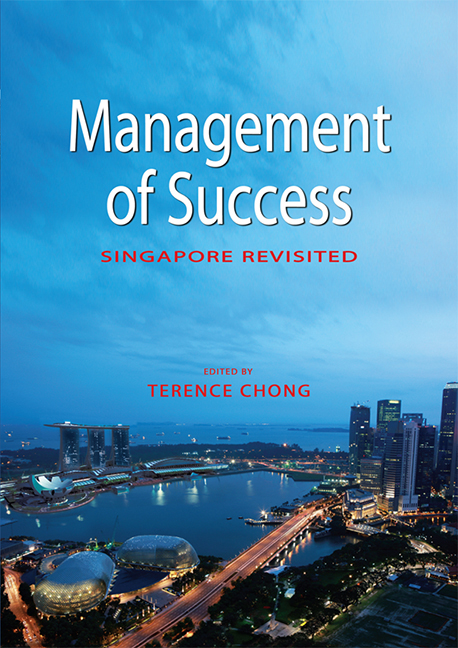Book contents
- Frontmatter
- Contents
- List of Tables and Figures
- Foreword
- Message
- Quote
- Preface
- The Contributors
- 1 Introduction: The Role of Success in Singapore's National Identity
- SECTION 1 SINGAPORE IN THE BIGGER PICTURE
- SECTION 2 LEADERSHIP, POLICY AND POLITICS
- SECTION 3 THE RESTRUCTURING OF THE ECONOMY
- SECTION 4 THE TRANSFORMATION OF SOCIETY
- SECTION 5 THE LAW
- SECTION 6 MODIFICATION OF THE ENVIRONMENT
- 21 The Greening of the Global City
- 22 Recovering from the “Promethean Hangover”? Critical Reflections on the Remaking of Singapore as a Global City
- 23 The Four Taps: Water Self-sufficiency in Singapore
- SECTION 7 COMMUNITY AND NATIONAL SECURITY
- SECTION 8 LIFE IN SINGAPORE
- Index
21 - The Greening of the Global City
from SECTION 6 - MODIFICATION OF THE ENVIRONMENT
Published online by Cambridge University Press: 21 October 2015
- Frontmatter
- Contents
- List of Tables and Figures
- Foreword
- Message
- Quote
- Preface
- The Contributors
- 1 Introduction: The Role of Success in Singapore's National Identity
- SECTION 1 SINGAPORE IN THE BIGGER PICTURE
- SECTION 2 LEADERSHIP, POLICY AND POLITICS
- SECTION 3 THE RESTRUCTURING OF THE ECONOMY
- SECTION 4 THE TRANSFORMATION OF SOCIETY
- SECTION 5 THE LAW
- SECTION 6 MODIFICATION OF THE ENVIRONMENT
- 21 The Greening of the Global City
- 22 Recovering from the “Promethean Hangover”? Critical Reflections on the Remaking of Singapore as a Global City
- 23 The Four Taps: Water Self-sufficiency in Singapore
- SECTION 7 COMMUNITY AND NATIONAL SECURITY
- SECTION 8 LIFE IN SINGAPORE
- Index
Summary
To achieve First World standards in a Third World region we set out to transform Singapore into a tropical garden city.
— Lee Kuan Yew, 2000THE GREEN CITY
The two characteristics that define modern Singapore, both at home and abroad, are its economic success and its clean and green image. Few would be surprised to hear that the policies for both originated from one man — Lee Kuan Yew, Singapore's first Prime Minister. They might, however, be surprised to find exactly how inextricably linked they were, both in their conception and implementation. In Minister Mentor (MM) Lee's own words, “After independence, I searched for some dramatic way to distinguish ourselves from other Third World countries. I settled for a clean and green Singapore”, and on pronouncing the success of this policy, MM Lee opines that “No other project has brought richer rewards to the region … it was good for morale, for tourists and for investors”, and “Greening is the most cost-effective project I have launched.” No one would quarrel with the effectiveness of these policies or that their successful implementation has transformed Singapore into a garden city that has brought the benefits so accurately predicted by MM Lee. But even successful policies invite criticism and it would be both interesting and instructive to examine some of the pertinent ones. In the 1989 volume of Management of Success, Stephen Yeh concluded that the Singapore Government's vision of a garden city will be one where “desirable economic and socio-cultural characteristics for individuals and society will [be] integrated with the highest possible environmental quality of the city”. This chapter will assess the balance between national economic priorities and nature conservation from the early 1990s by examining the evolving relationship between the state and the green movement in Singapore.
A LACK OF DIVERSITY
Despite the successful transformation of Singapore into a garden city in a remarkably short time, some sections of society have voiced dissatisfaction with, not so much the greening itself, but the manner in which it was achieved. Criticisms have been made on the regimented uniformity of the roadside trees, the monotony of manicured grass verges, the sterility of public parks, the proliferation of golf courses (the ultimate in manicured green), and above all, the loss of nature areas, agricultural land, and other green, open spaces.
- Type
- Chapter
- Information
- Management of SuccessSingapore Revisited, pp. 387 - 399Publisher: ISEAS–Yusof Ishak InstitutePrint publication year: 2010

